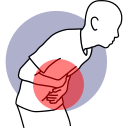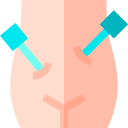LAPAROSCOPIC HERNIA
Laparoscopic Hernia
Laparoscopic Hernia Surgery is a modern way to fix hernias using small cuts. Dr. Pallab Saha is really good at it, making sure you feel better with less pain and smaller scars. If you have a hernia, talking to Dr. Pallab Saha is a smart idea for top-notch care and a quicker recovery. Trust in this cool method to get back to your regular activities in no time!

Here are the top 6 Steps Involved in a Laparoscopic Hernia Surgery
Small incisions are made in the abdominal wall, and trocars (tubes) are inserted to create a pneumoperitoneum by inflating the abdomen with carbon dioxide gas. This provides a working space for the laparoscope and instruments.
A laparoscope, a thin tube with a camera, is inserted through one of the trocars, providing a magnified view of the hernia and surrounding tissues on a monitor.
The surgeon identifies the hernia sac and reduces it back into the abdominal cavity. This step may involve separating the sac from the surrounding tissues.
A synthetic mesh is introduced through one of the trocars and positioned over the hernia defect to reinforce the weakened area and prevent a recurrence.
The mesh is securely fixed in place using specialized instruments, such as staples, tacks, or sutures, to ensure stability and proper coverage of the hernia defect.
After confirming the successful placement and fixation of the mesh, the instruments and trocars are removed. The small incisions are closed with sutures or surgical staples, and the patient is moved to a recovery area for postoperative monitoring.

Changes in Bowel Habits
In some cases, hernias, especially those involving the intestine, can cause changes in bowel habits, such as constipation or difficulty passing gas.
Laparoscopic Hernia Disease Symptoms
Hernias are often associated with noticeable symptoms, and while laparoscopic hernia surgery is a treatment rather than a cause of symptoms, it’s important to recognize the signs of a hernia.

Pain or Discomfort
Pain or discomfort at the site of the bulge is typical, especially during activities like lifting, coughing, or sneezing. The pain may vary from mild to severe.

Aching or Burning Sensation
Some individuals with hernias may experience an aching or burning sensation at the bulge site or in the surrounding area.

Feeling of Heaviness
Individuals with hernias may describe a feeling of heaviness or pressure in the abdomen, particularly when standing for extended periods.

Swelling or Tenderness
The area around the bulge may become swollen or tender to the touch, indicating inflammation or irritation.
Best Laparoscopic Hernia Surgery Surgeon in Kolkata, West Bengal

Highest Success Rate
Experience Laparoscopic Hernia Surgery with the highest success rate under the expertise of Dr. Pallab Saha in Kolkata. Trust in his proficiency for optimal outcomes and a smooth recovery process

Certified Laparoscopic Hernia Surgery
Experience certified excellence in Laparoscopic Hernia Surgery with Dr. Pallab Saha. Trust a surgeon with the expertise and certification to ensure a safe and successful procedure.

Premium Laparoscopic Hernia Surgery
Discover premium care with Dr. Pallab Saha for Laparoscopic Hernia Surgery. Experience advanced techniques and personalized attention for optimal results in a state-of-the-art surgical setting
Best Laparoscopic Hernia Surgery Surgeon in Kolkata | Dr. Pallab Saha
Experience top-notch care with Dr. Pallab Saha, the best Laparoscopic Hernia Surgery Surgeon in Kolkata. For emergencies, Contact with us. Your health is our priority.
The Pros of Laparoscopic Hernia Surgery
Laparoscopic hernia surgery involves small incisions, minimizing trauma to surrounding tissues and reducing postoperative pain.
Patients typically experience a quicker recovery period after laparoscopic hernia surgery, allowing them to return to normal activities sooner.
The smaller incisions result in smaller scars, contributing to better cosmetic outcomes and reduced long-term visibility of scars.
The minimally invasive nature of the procedure decreases the risk of infection compared to open surgery, as there is less exposed tissue.
Laparoscopic surgery generally involves less blood loss than traditional open surgery, contributing to a safer surgical experience.
Laparoscopic hernia surgery allows for the repair of bilateral (both sides) hernias in a single procedure, minimizing the need for multiple surgeries.
The use of mesh in laparoscopic hernia repair helps strengthen the weakened tissue, reducing the risk of hernia recurrence.
Surgeons use a laparoscope to view the internal structures, providing a magnified and clearer view, enhancing the precision of the repair.
Frequently Asked Questions
From recovery timelines to potential risks, find comprehensive answers for a clear understanding of this minimally invasive procedure.
Laparoscopic Hernia Surgery is a minimally invasive procedure to repair hernias using small incisions, specialized instruments, and a laparoscope for enhanced precision.
Laparoscopic hernia repair is a type of surgery that's not too invasive, which makes it safe like open repair in the right situations. But, like any surgery, there's a small chance of problems. Some risks include reacting to the anesthesia.
After laparoscopic hernia repair, most people can go home on the same day. It takes about 1 to 2 weeks to recover. You can start doing light activities after 1 to 2 weeks, but wait for about 4 weeks before doing tough exercises.
Unlike traditional open surgery with a large incision, Laparoscopic Hernia Surgery involves small incisions, leading to less tissue trauma, reduced pain, and quicker recovery.
Dr. Pallab Saha is the go-to Laparoscopic Hernia Surgery Surgeon in Kolkata. With expertise and care, he ensures the best outcomes for hernia patients. Consult Dr. Pallab Saha for top-notch treatment.
Laparoscopic hernia surgery in Kolkata can cost between ₹50,000 to ₹70,000, based on the hospital and surgeon's skills. On average, it's around ₹60,000. Remember, these are just estimates

